Electronically Tunable Current Controlled Current Conveyor Transconductance Amplifier-Based Mixed-Mode Biquadratic Filter with Resistorless and Grounded Capacitors
Abstract
:1. Introduction
2. Circuit Descriptions
2.1. Basic Concept and Implementation of the CCCCTA
2.2. Proposed Electronically-Tunable Mixed-Mode Biquadratic Filter
2.2.1. CM and TIM
2.2.2. VM and TAM
2.3. Non-Ideal Analysis and Sensitivity Performance
2.4. Effect of the CCCCTA Parasitic Impedances and Design Considerations
3. Simulation Results
3.1. Pre-Layout Simulation
3.2. Post-Layout Simulation
4. Conclusions
Acknowledgments
Author Contributions
Conflicts of Interest
References
- Wilson, B. Recent developments in current conveyors and current-mode circuits. IEE Proc. G Circuits Devices Syst. 1990, 137, 63–77. [Google Scholar] [CrossRef]
- Schmid, H. Why “current mode” does not guarantee good performance. Analog Integr. Circuits Signal Process. 2003, 35, 79–90. [Google Scholar] [CrossRef]
- Cicekoglu, O.; Tarim, N.; Kuntman, H. Wide dynamic range high output impedance current-mode multifunction filters with dual-output current conveyors. AEU Int. J. Electron. Commun. 2002, 56, 55–60. [Google Scholar] [CrossRef]
- Chang, C.M.; Al-Hashimi, B.M.; Rose, J.N. Unified active filter baquad structures. IEE Proc. Circuits Devices Syst. 2004, 151, 273–277. [Google Scholar] [CrossRef]
- Maheshwari, S. High input impedance VM-APSs with grounded passive elements. IET Circuits Devices Syst. 2007, 1, 72–78. [Google Scholar] [CrossRef]
- Maheshwari, S. High output impedance current-mode all-pass sections with two grounded passive components. IET Circuits Devices Syst. 2008, 2, 234–242. [Google Scholar] [CrossRef]
- Hwang, Y.S.; Liu, W.H.; Tu, S.H.; Chen, J.J. New building block: Multiplication-mode current conveyor. IET Circuits Devices Syst. 2009, 3, 41–48. [Google Scholar] [CrossRef]
- Maheshwari, S. Analogue signal processing applications using a new circuit topology. IET Circuits Devices Syst. 2009, 3, 106–115. [Google Scholar] [CrossRef]
- Maheshwari, S.; Mohan, J.; Chauhan, D.S. Voltage-mode cascadable all-pass sections with two grounded passive components and one active element. IET Circuits Devices Syst. 2010, 4, 113–122. [Google Scholar] [CrossRef]
- Maheshwari, S.; Chaturvedi, B. High-input low-output impedance all-pass filters using one active element. IET Circuits Devices Syst. 2012, 6, 103–110. [Google Scholar] [CrossRef]
- Abdalla, K.K.; Bhaskar, D.R.; Senani, R. Configuration for realizing a current-mode universal filter and dual-mode quadrature single resistor controlled oscillator. IET Circuits Devices Syst. 2012, 6, 159–167. [Google Scholar] [CrossRef]
- Ibrahim, M.A.; Minaei, S.; Kuntman, H. A 22.5 MHz current-mode KHN-biquad using differential voltage current conveyor and grounded passive elements. Int. J. Electron. Commun. 2005, 59, 311–318. [Google Scholar] [CrossRef]
- Abuelma’atti, M.T.; Bentrcia, A.; Al-Shahrani, S.M. A novel mixed-mode current-conveyor-based filter. Int. J. Electron. 2004, 91, 191–197. [Google Scholar] [CrossRef]
- Pandey, N.; Paul, S.K.; Bhattacharyya, A.; Jain, S.B. A new mixed mode biquad using reduced number of active and passive elements. IEICE Electron. Express 2006, 3, 115–121. [Google Scholar] [CrossRef]
- Singh, V.K.; Singh, A.K.; Bhaskar, D.R.; Senani, R. Novel mixed-mode universal biquad configuration. IEICE Electron. Express 2005, 2, 548–553. [Google Scholar] [CrossRef]
- Minaei, S.; Ibrahim, M.A. A mixed-mode KHN-biquad using DVCC and grounded passive elements suitable for direct cascading. Int. J. Circuits Theory Appl. 2009, 37, 793–810. [Google Scholar] [CrossRef]
- Liao, W.B.; GU, J.C. SIMO type universal mixed-mode biquadratic filter. Indian J. Eng. Mater. Sci. 2011, 18, 443–448. [Google Scholar]
- Lee, C.N.; Chang, C.M. Single FDCCII-based mixed-mode biquad filter with eight outputs. AEU Int. J. Electron. Commun. 2009, 63, 736–742. [Google Scholar] [CrossRef]
- Shah, N.A.; Malik, M.A. Multifunction mixed-mode filter using FTFNs. Analog Integr. Circuits Process. 2006, 47, 339–343. [Google Scholar] [CrossRef]
- Abuelma’atti, M.T.; Bentrcia, A. A novel mixed-mode OTA-C universal filter. Int. J. Electron. 2005, 92, 375–383. [Google Scholar] [CrossRef]
- Chen, H.P.; Liao, Y.Z.; Lee, W.T. Tunable mixed-mode OTA-C universal filter. Analog Integr. Circuits Process. 2009, 58, 135–141. [Google Scholar] [CrossRef]
- Lee, C.N. Multiple-mode OTA-C universal biquad filters. Circuits Syst. Signal Process. 2010, 29, 263–274. [Google Scholar] [CrossRef]
- Pandey, N.; Paul, S.K. Mixed-mode universal filter. J. Circuits Syst. Comput. 2013, 22, 1250064. [Google Scholar] [CrossRef]
- Li, Z.J. Mixed-mode universal filter using MCCCII. AEU Int. J. Electron. Commun. 2009, 63, 1072–1075. [Google Scholar]
- Pandey, N.; Paul, S.K. SIMO mixed mode universal filter. J. Act. Passiv. Eletron. Devices 2012, 7, 215–226. [Google Scholar]
- Maheshwari, S.; Singh, S.V.; Chauhan, D.S. Electronically tunable low-voltage mixed-mode universal biquad filter. IET Circuits Devices Syst. 2011, 5, 149–158. [Google Scholar] [CrossRef]
- Singh, S.V.; Maheshwari, S.; Chauhan, D.S. Novel electronically tunable mixed-mode biqaud filter. In Electronics and Signal Processing, Lecture Notes in Electrical Engineering (LNEE); Springer: Berlin/Heidelberg, Germany, 2011; Volume 97, pp. 735–742. [Google Scholar]
- Siripruchyanun, M.; Jaikla, W. Current controlled current conveyor transconductance amplifier (CCCCTA): A building block for analog signal processing. Electr. Eng. 2008, 9, 443–455. [Google Scholar] [CrossRef]
- Jaikla, W.; Siripongdee, S.; Suwanjan, P. MISO current-mode biquad filter with independent control of pole frequency and quality factor. Radioengineering 2012, 21, 886–891. [Google Scholar]
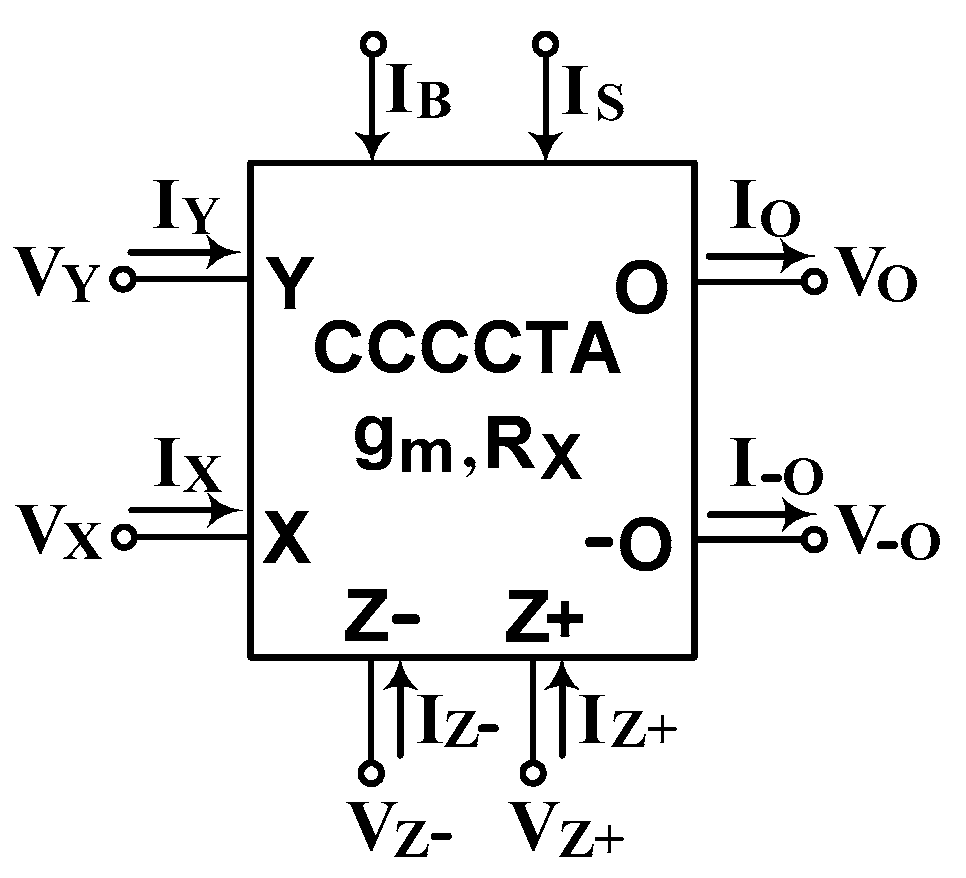
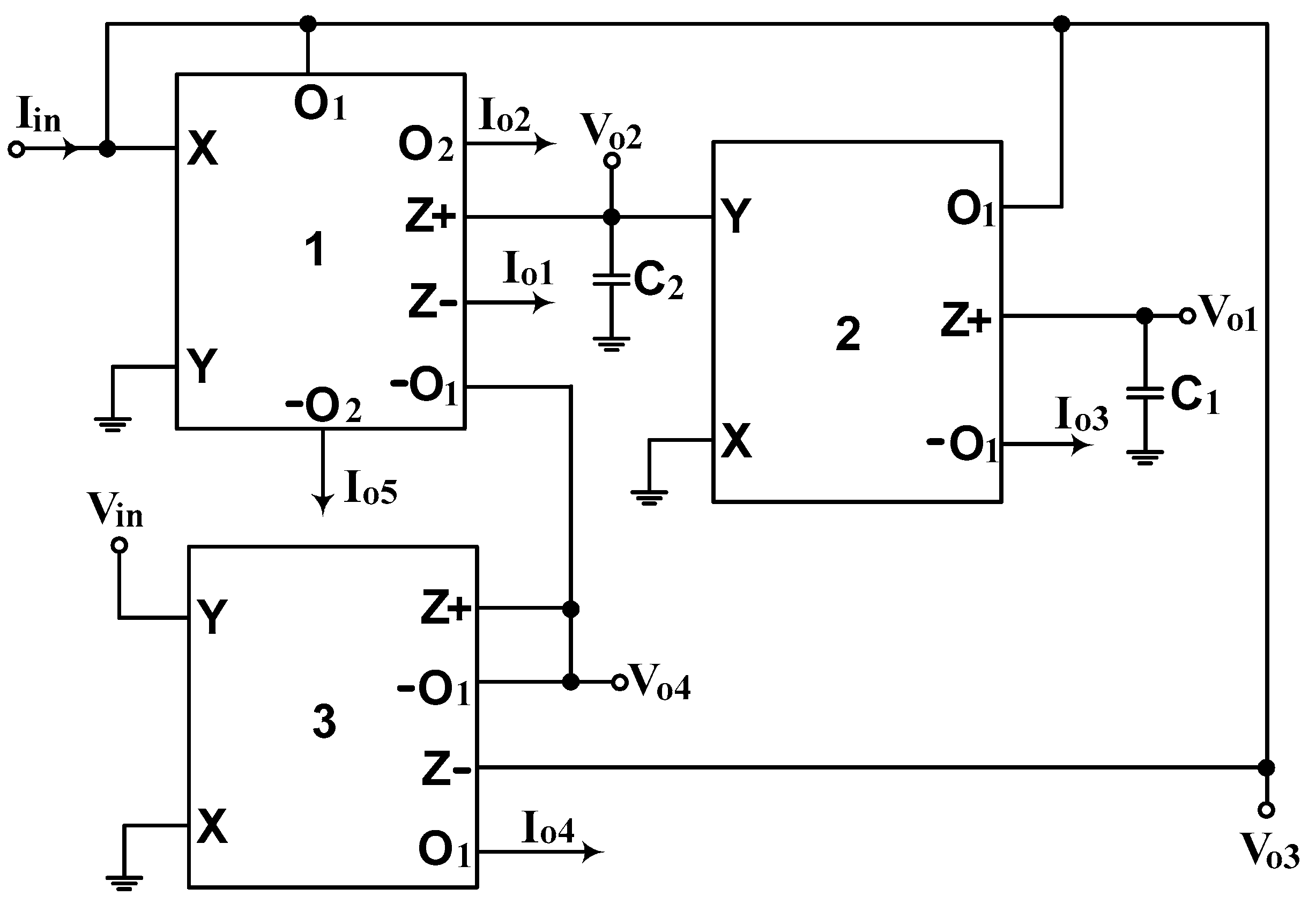
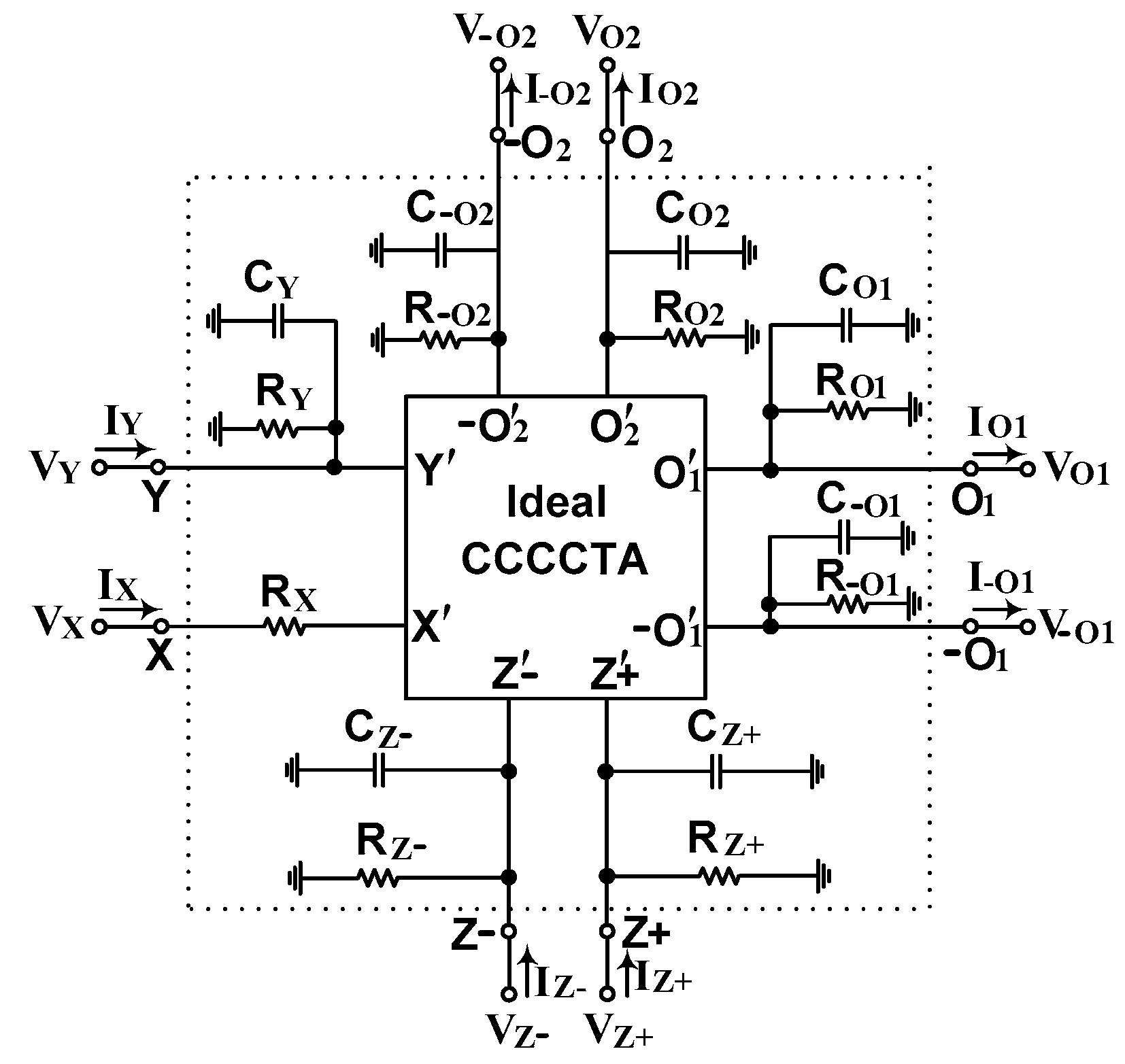

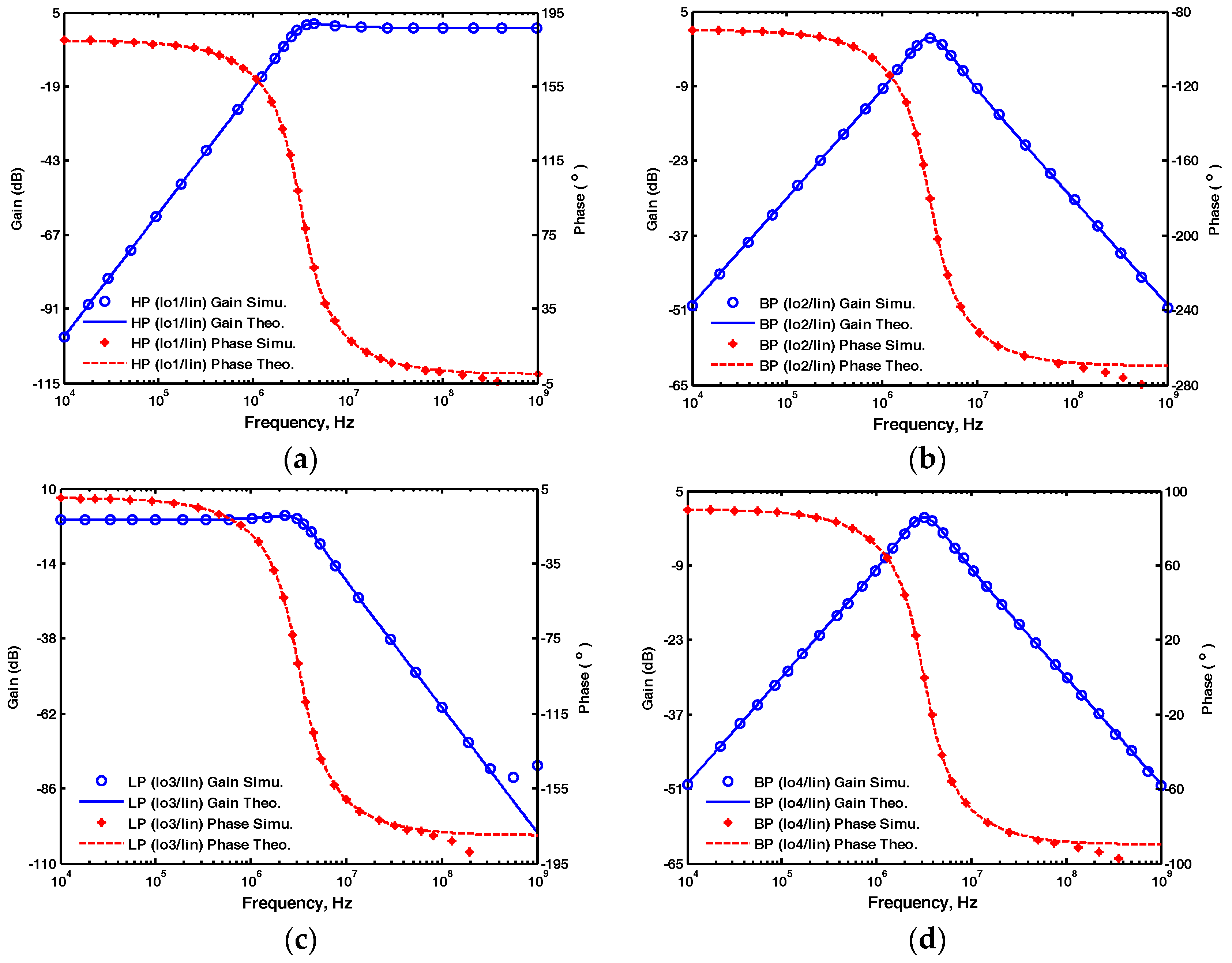

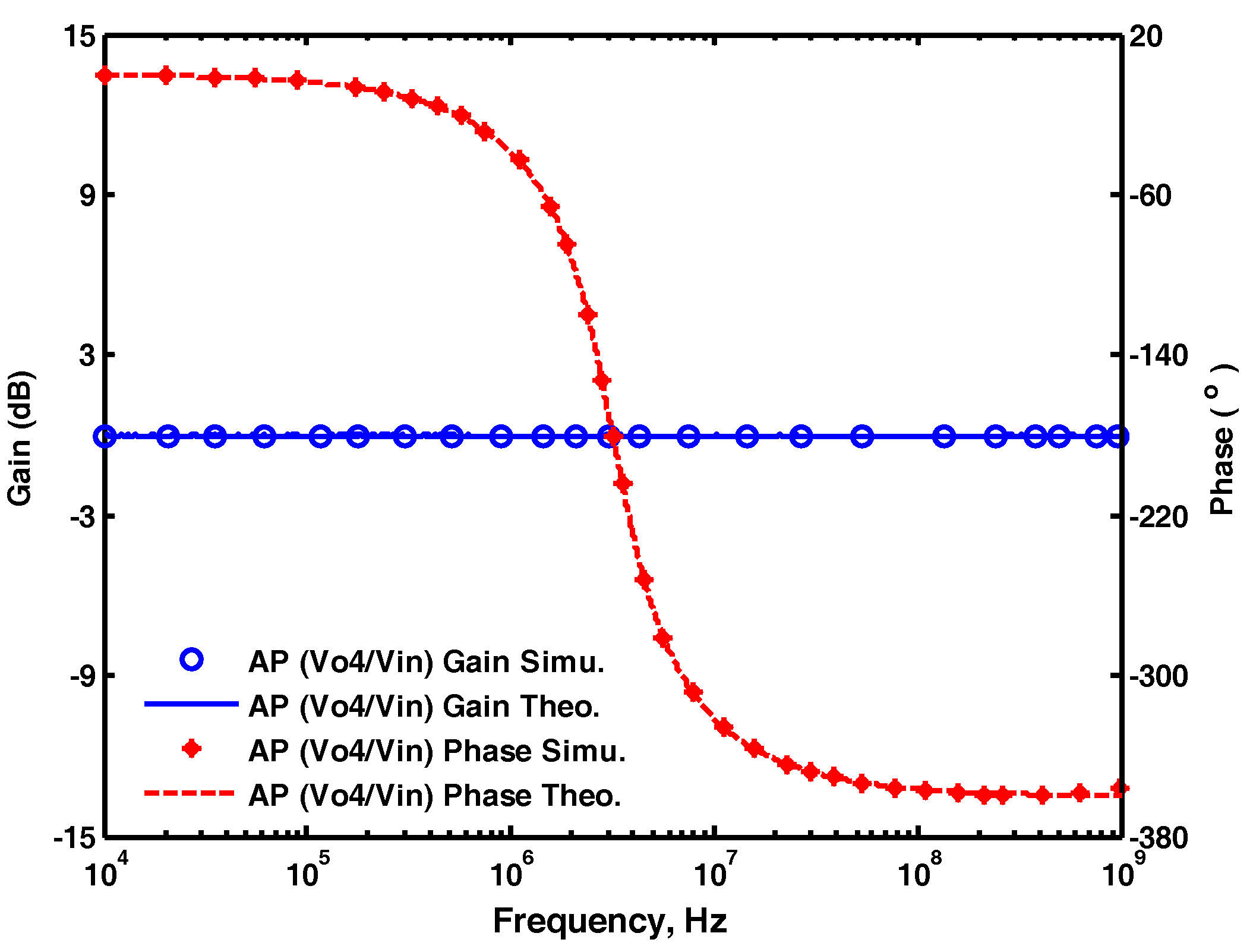
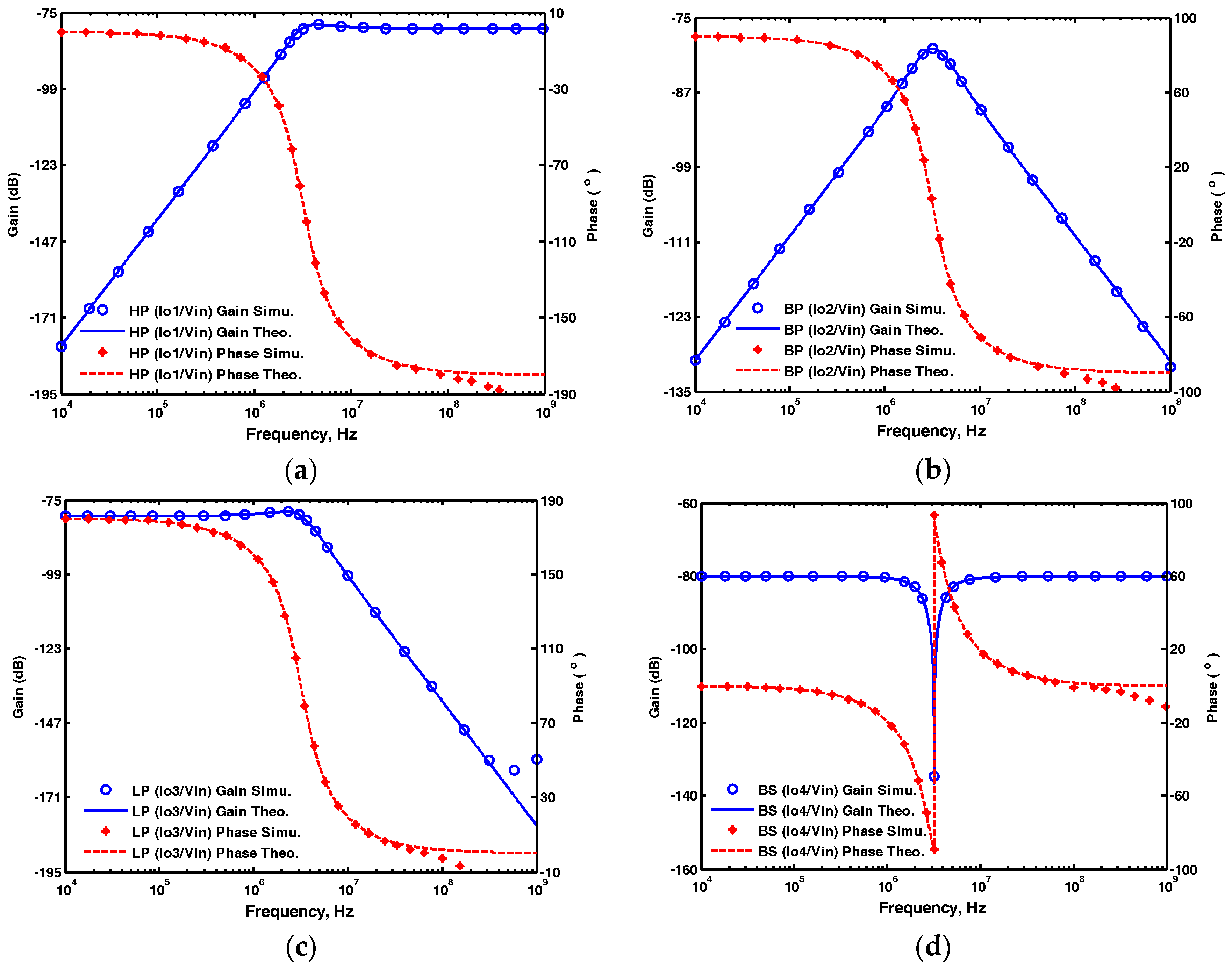
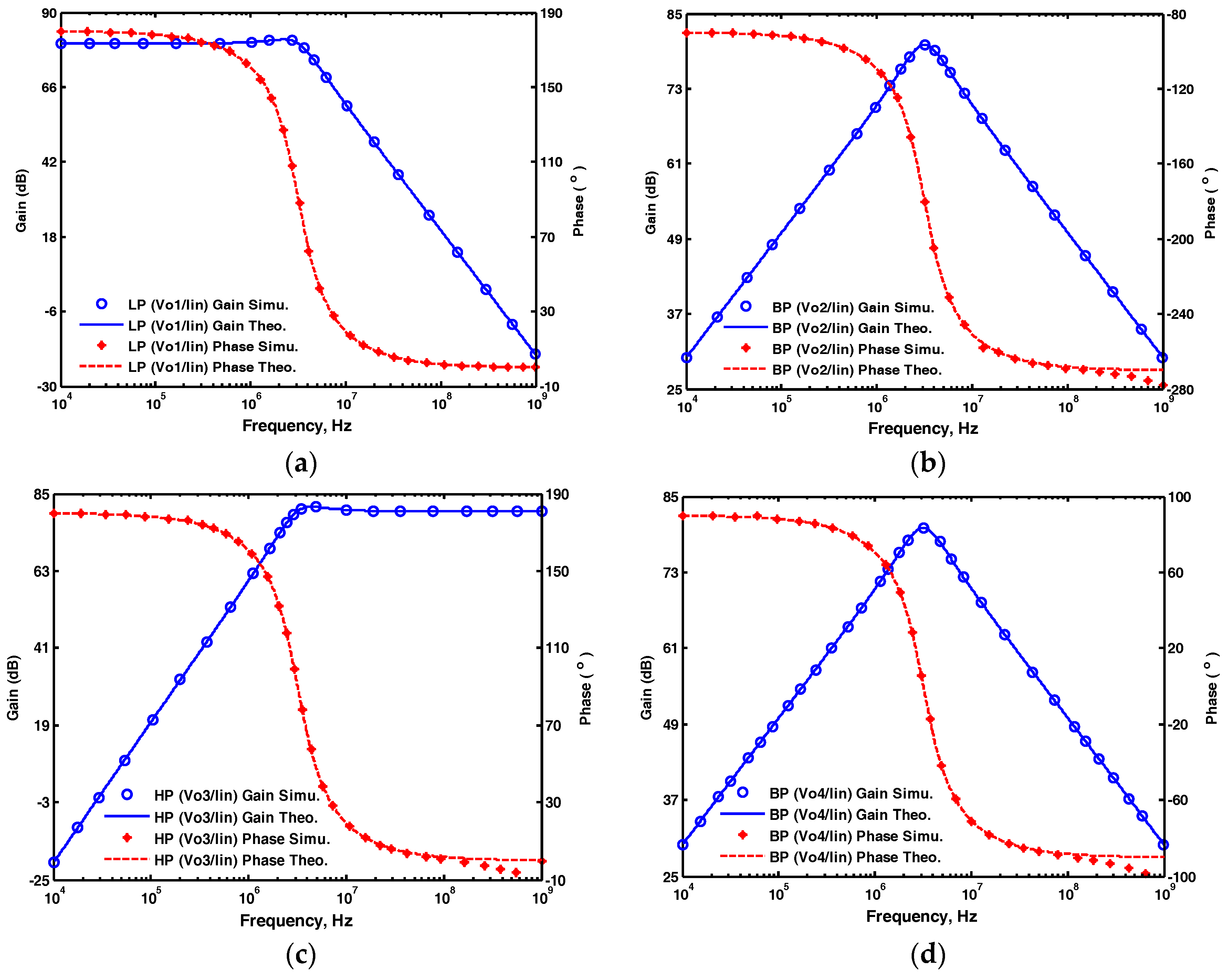
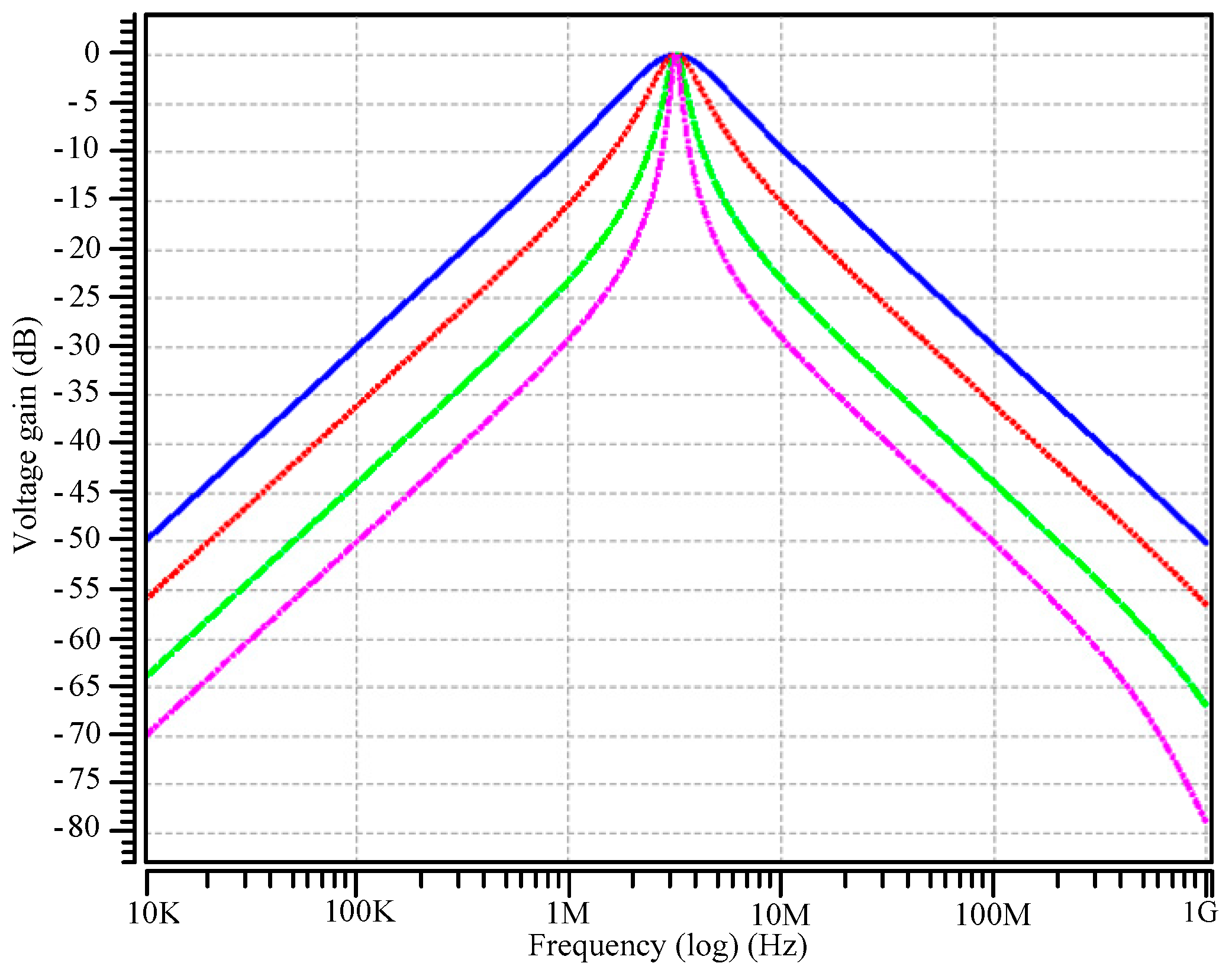

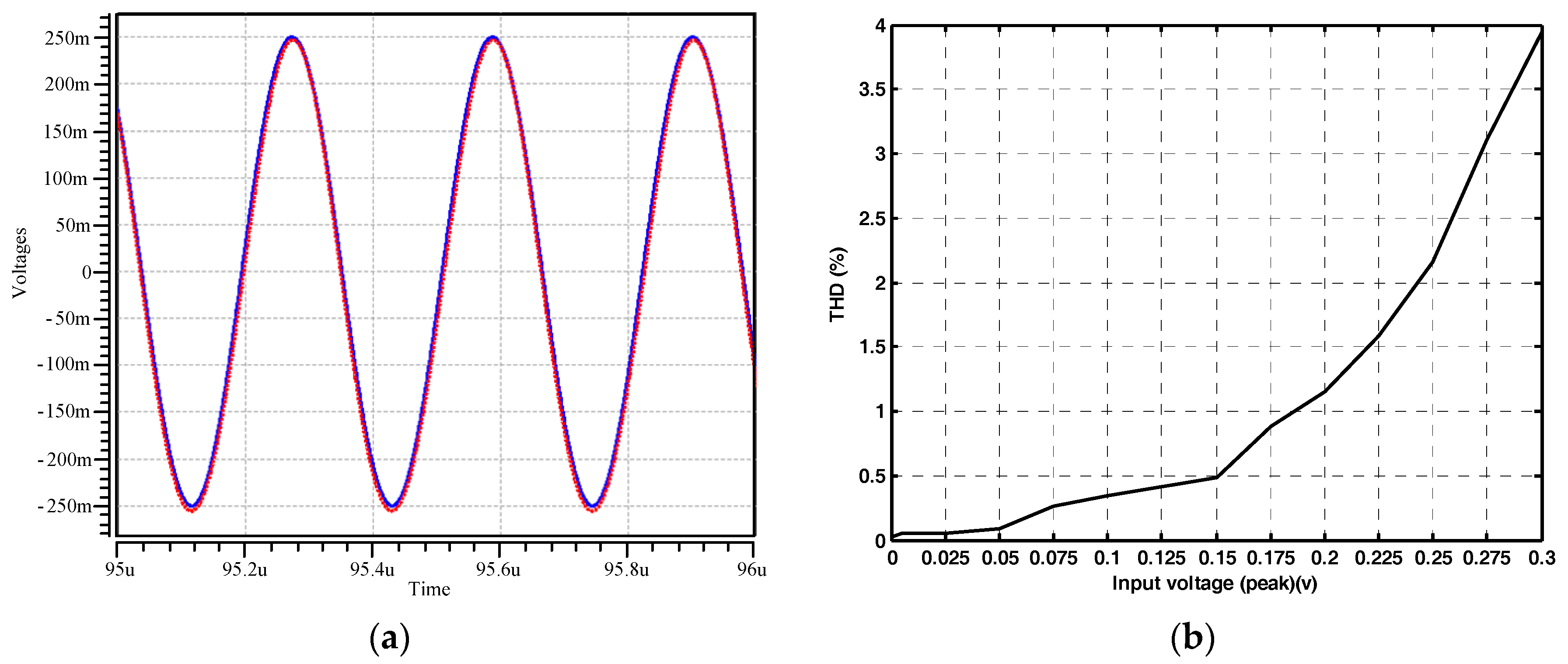
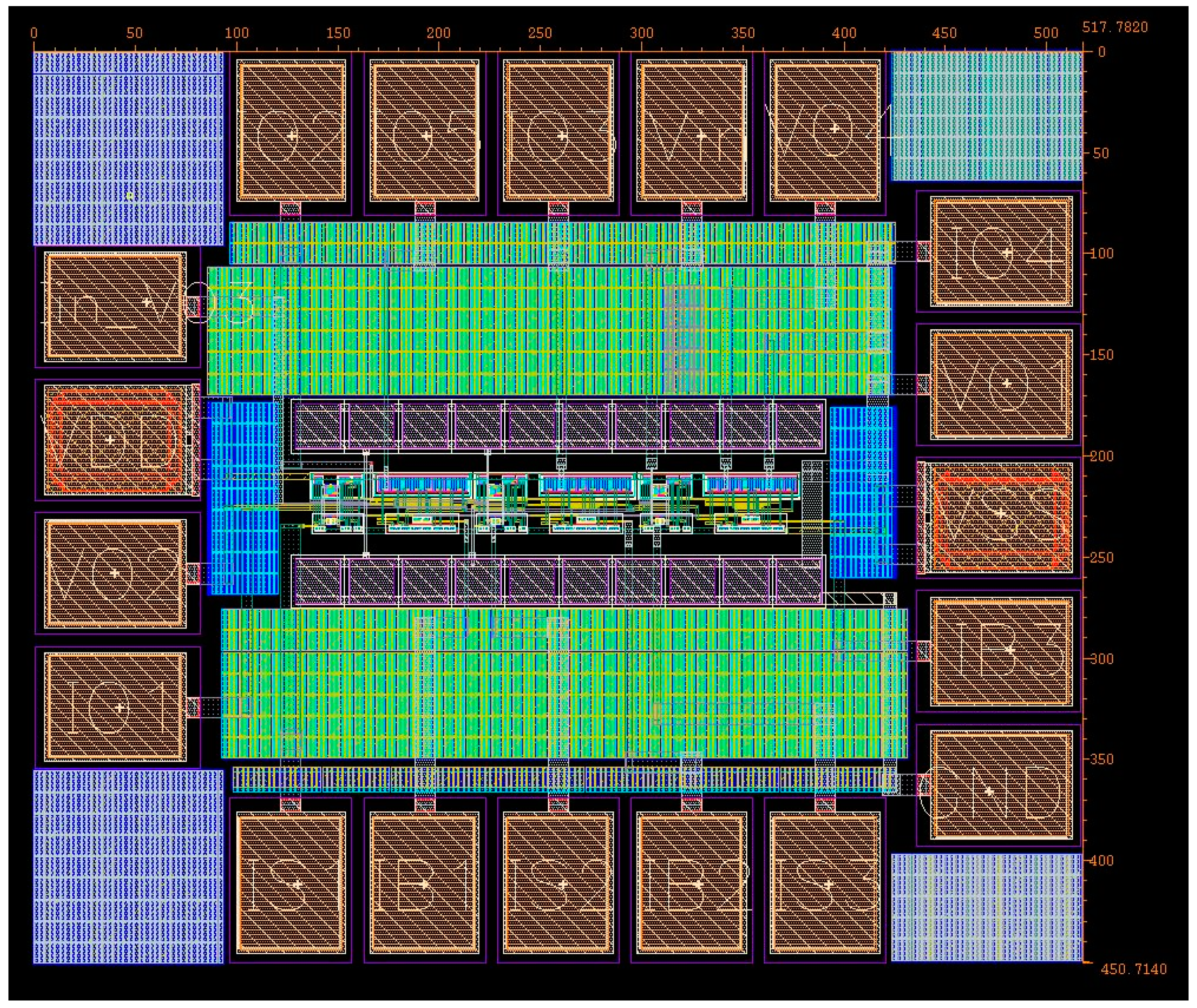
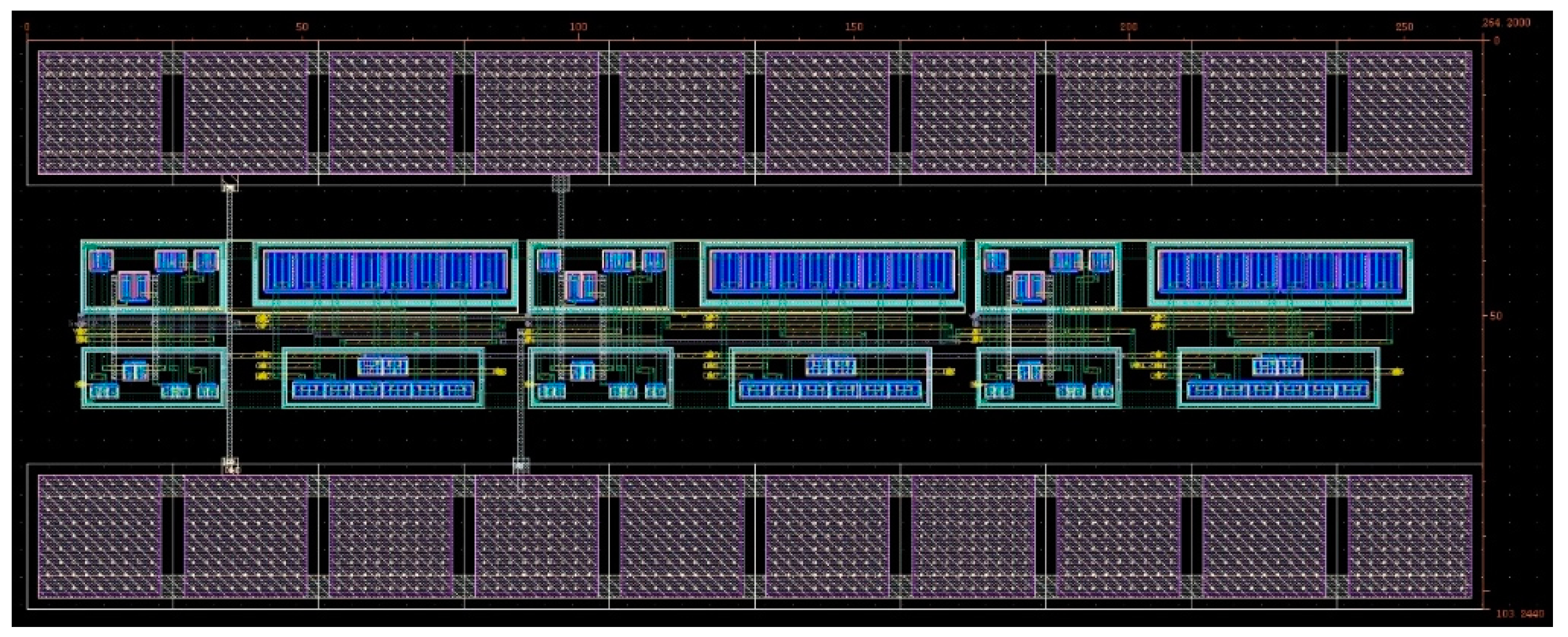


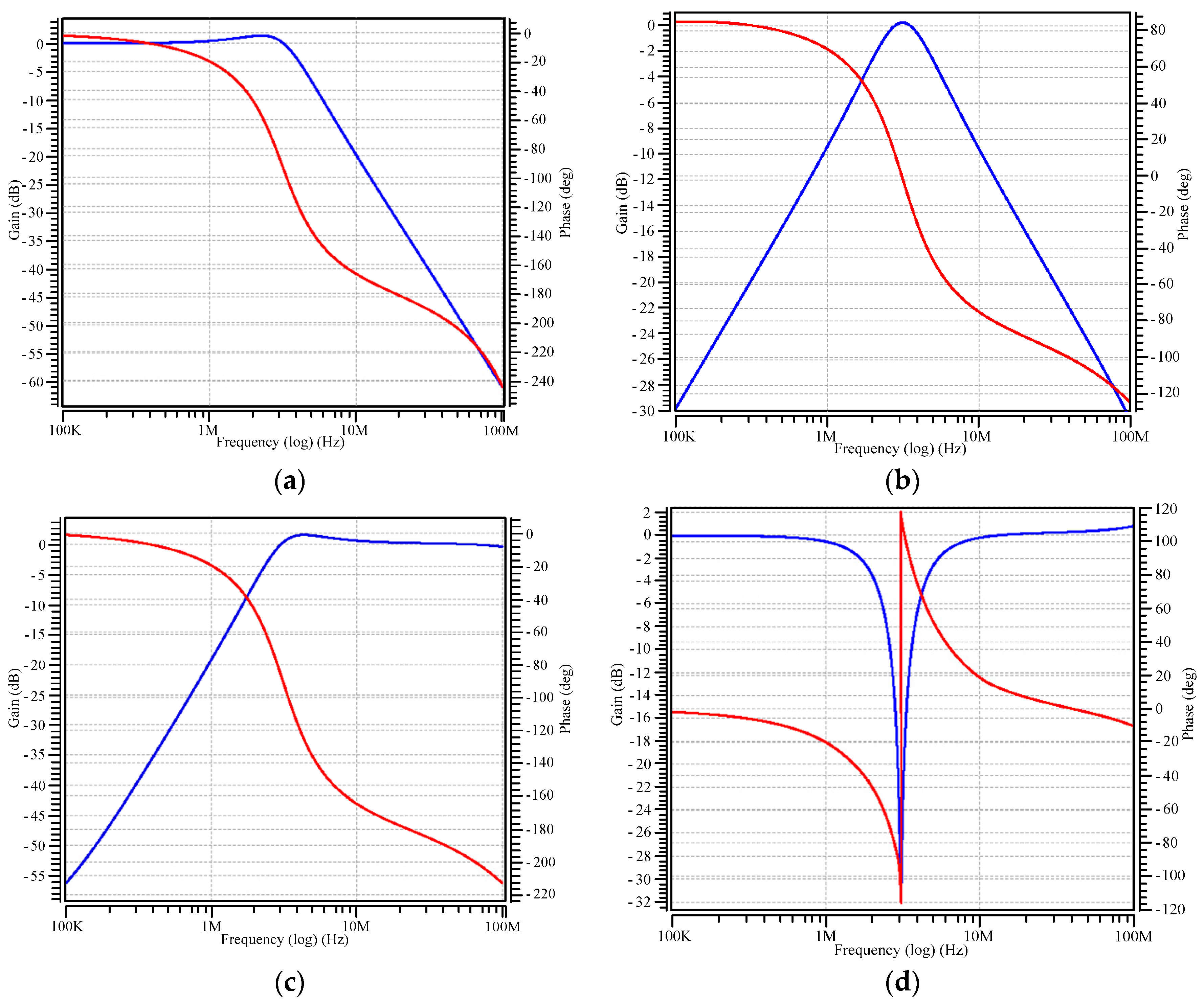
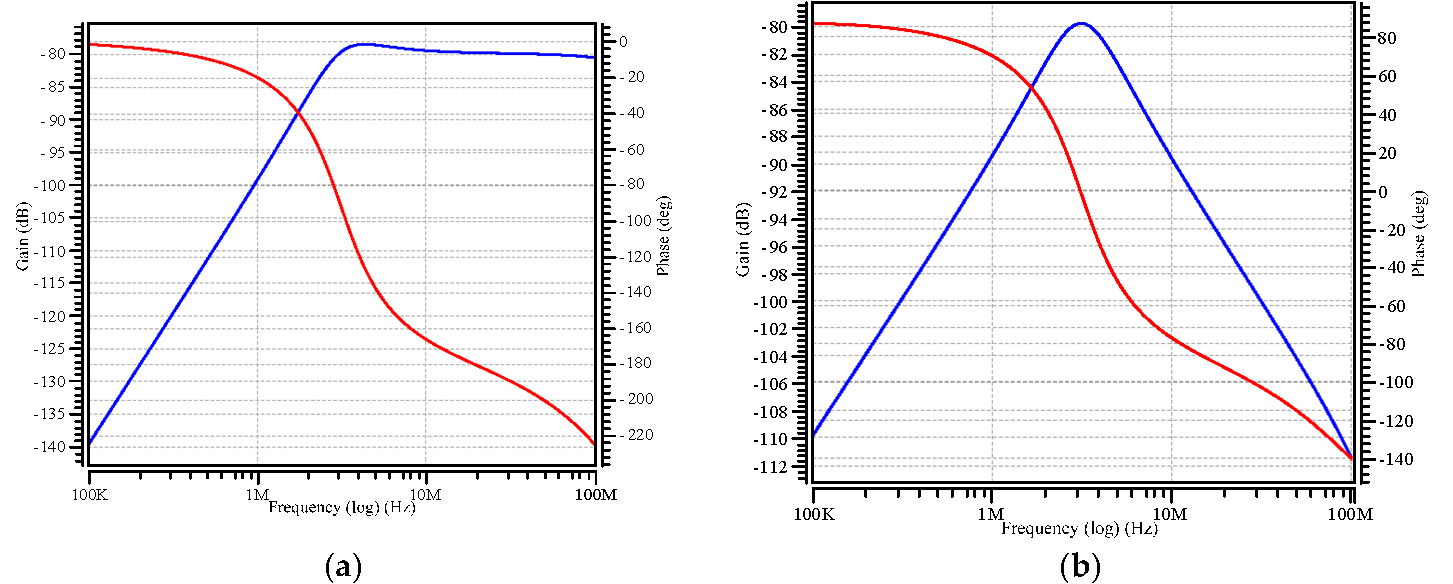

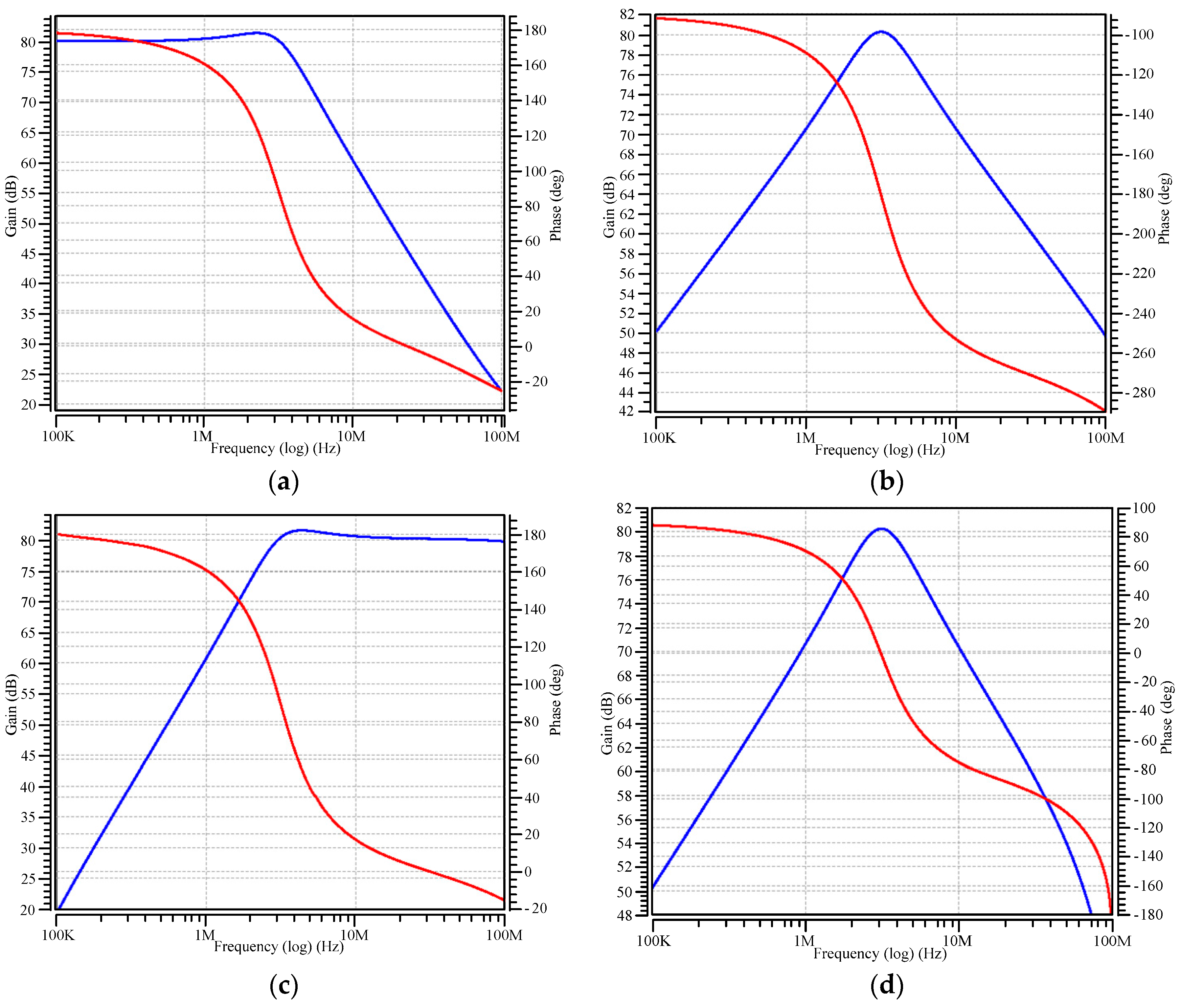
| Filters | No. of Active Elements | No. of Passive Elements | Composed of Equivalent Active Elements |
|---|---|---|---|
| [13] | 7 CCII | 2C + 8R | 7 CCII |
| [14] | 3 CCII | 3C + 4R + 2 switch | 3 CCII |
| [15] | 4 CFOA | 2C + 9R + 1 switch | 4 CFOA |
| [16] | 3 DVCC | 2C + 3R | 3 DVCC |
| [17] | 3 DDCC | 2C + 4R | 3 DDCC |
| [18] | 1 FDCCII | 2C + 3R | 2 DDCC |
| [19] | 3 FTFN | 2C + 3R | 3 × 2 CFOA |
| [20] | 7 OTA | 2C | 7 OTA |
| [21] | 5 OTA | 2C | 5 OTA |
| [22] | 4 OTA | 2C | 4 OTA |
| [23] | 4 MOCCCII | 2C | 4 MOCCCII |
| [24] | 5 MOCCCII | 2C | 5 MOCCCII |
| [25] | 4 MOCCCII | 2C | 4 MOCCCII |
| [26] | 3 CCCCTA | 2C | 3 × (1 CCCII + 1 OTA) |
| [27] | 3 CCCCTA | 2C | 3 × (1 CCCII + 1 OTA) |
| this work | 3 CCCCTA | 2C | 3 × (1 CCCII + 1 OTA) |
| Filters | Properties 1 | ||||||||
|---|---|---|---|---|---|---|---|---|---|
| (1) | (2) | (3) | (4) | (5) | (6) | (7) | (8) | (9) | |
| [13] | no | no | no | no | no | yes | yes | yes | yes |
| [14] | no | no | no | no | no | yes | no | yes | yes |
| [15] | no | no | no | no | no | yes | no | yes | yes |
| [16] | no | no | no | yes | yes | yes | yes | no | yes |
| [17] | no | yes | no | no | no | yes | yes | no | yes |
| [18] | no | no | no | no | no | yes | yes | no | no |
| [19] | no | no | no | no | no | no | no | no | yes |
| [20] | yes | no | no | no | yes | yes | yes | yes | yes |
| [21] | yes | no | no | no | yes | yes | yes | no | yes |
| [22] | yes | no | no | no | yes | yes | no | no | yes |
| [23] | yes | no | no | yes | yes | yes | no | no | yes |
| [24] | yes | yes | no | no | no | yes | yes | no | yes |
| [25] | yes | yes | no | yes | no | yes | no | no | yes |
| [26] | yes | yes | no | no | yes | yes | no | no | yes |
| [27] | yes | yes | no | yes | yes | yes | yes | no | yes |
| this work | yes | yes | yes | yes | yes | yes | yes | yes | yes |
| Related Works | No. of Active Elements | Filter Function Realization | The ωo and Q Orthogonal Tunability | Independent Tunability VM Filter Gains without Affecting ωo and Q | |||
|---|---|---|---|---|---|---|---|
| CM | VM | TAM | TIM | ||||
| [26] | 3 | All five | LP, BP, HP | All five | LP, BP, HP | no | no |
| [27] | 3 | All five | LP, BP, BS | All five | LP, BP, BS | yes | no |
| this work | 3 | All five | All five | All five | LP, BP, HP | yes | yes |
| Related Works | Matching Constraints | Input Voltage at High Input Impedance | Input Current at Low Input Impedance | Output Current at High Output Impedance |
|---|---|---|---|---|
| [26] | AP | yes | no | yes |
| [27] | AP | yes | yes | yes |
| this work | nil | yes | yes | yes |
| Filter function | Vin = 0, Iin is Input Signal | Iin = 0, Vin is Input Signal | ||
|---|---|---|---|---|
| CM | TIM | VM | TAM | |
| HP | Io1 | Vo3 | Vo3 | Io1 |
| LP | Io3 | Vo1 | Vo1 | Io3 |
| BP | Io2, Io4, Io5 | Vo2, Vo4 | Vo2 | Io2, Io5 |
| BS | Io1 + Io3 | --- | Vo4 | Io4 |
| AP | Io1 + Io2 + Io3 | --- | Vo4 * | Io4 + Io5 |
| Transistors | Length (µm) | Width (µm) |
|---|---|---|
| M1–M2 | 0.18 | 5 |
| M3–M4 | 0.18 | 8 |
| M5–M11 | 0.18 | 5 |
| M12–M19 | 0.18 | 3 |
| M20–M21 | 0.5 | 10 |
| M22–M29 | 0.8 | 25 |
| M30–M35 | 0.8 | 8 |
| Bias Current IB1 (µA) | Bias Current IS3 (µA) | Quality Factor |
|---|---|---|
| 24.135 | 1.7782 | Q = 1 |
| 6.035 | 0.4446 | Q = 2 |
| 0.966 | 0.0712 | Q = 5 |
| 0.241 | 0.0178 | Q = 10 |
| Bias Currents IB1 = IB2 = IB3 | Bias Currents IS1 = IS2 = IS3 | Capacitances C1 = C2 | Calculated Value of fo | Simulated Value of fo | Frequency Error |
|---|---|---|---|---|---|
| 10.726 µA (gm = 66.67 µS) | 0.79 µA (RX = 15 kΩ) | 5 pF | 2.122 MHz | 2.13 MHz | 0.3% |
| 24.135 µA (gm = 100 µS) | 1.7782 µA (RX = 10 kΩ) | 5 pF | 3.183 MHz | 3.22 MHz | 1.62% |
| 42.902 µA (gm = 133.33 µS) | 3.161 µA (RX = 7.5 kΩ) | 5 pF | 4.244 MHz | 4.32 MHz | 1.79% |
| 96.5 µA (gm = 200 µS) | 7.113 µA (RX = 5 kΩ) | 5 pF | 6.366 MHz | 6.48 MHz | 1.79% |
© 2017 by the authors. Licensee MDPI, Basel, Switzerland. This article is an open access article distributed under the terms and conditions of the Creative Commons Attribution (CC BY) license ( http://creativecommons.org/licenses/by/4.0/).
Share and Cite
Chen, H.-P.; Yang, W.-S. Electronically Tunable Current Controlled Current Conveyor Transconductance Amplifier-Based Mixed-Mode Biquadratic Filter with Resistorless and Grounded Capacitors. Appl. Sci. 2017, 7, 244. https://doi.org/10.3390/app7030244
Chen H-P, Yang W-S. Electronically Tunable Current Controlled Current Conveyor Transconductance Amplifier-Based Mixed-Mode Biquadratic Filter with Resistorless and Grounded Capacitors. Applied Sciences. 2017; 7(3):244. https://doi.org/10.3390/app7030244
Chicago/Turabian StyleChen, Hua-Pin, and Wan-Shing Yang. 2017. "Electronically Tunable Current Controlled Current Conveyor Transconductance Amplifier-Based Mixed-Mode Biquadratic Filter with Resistorless and Grounded Capacitors" Applied Sciences 7, no. 3: 244. https://doi.org/10.3390/app7030244





